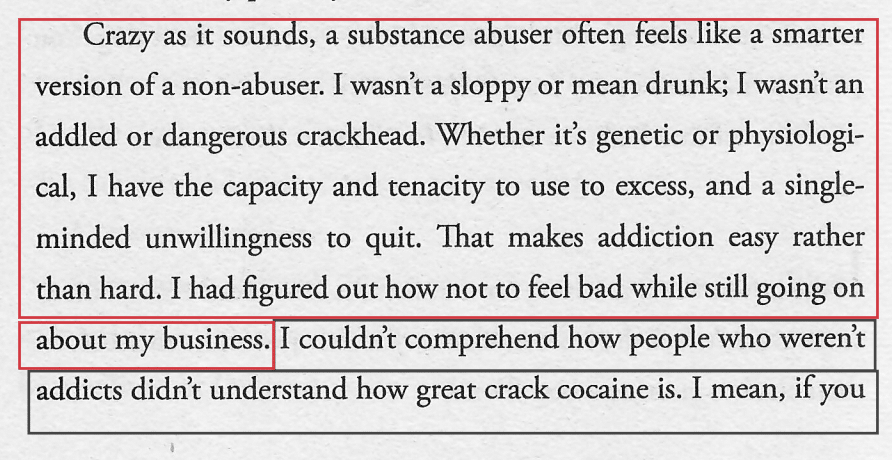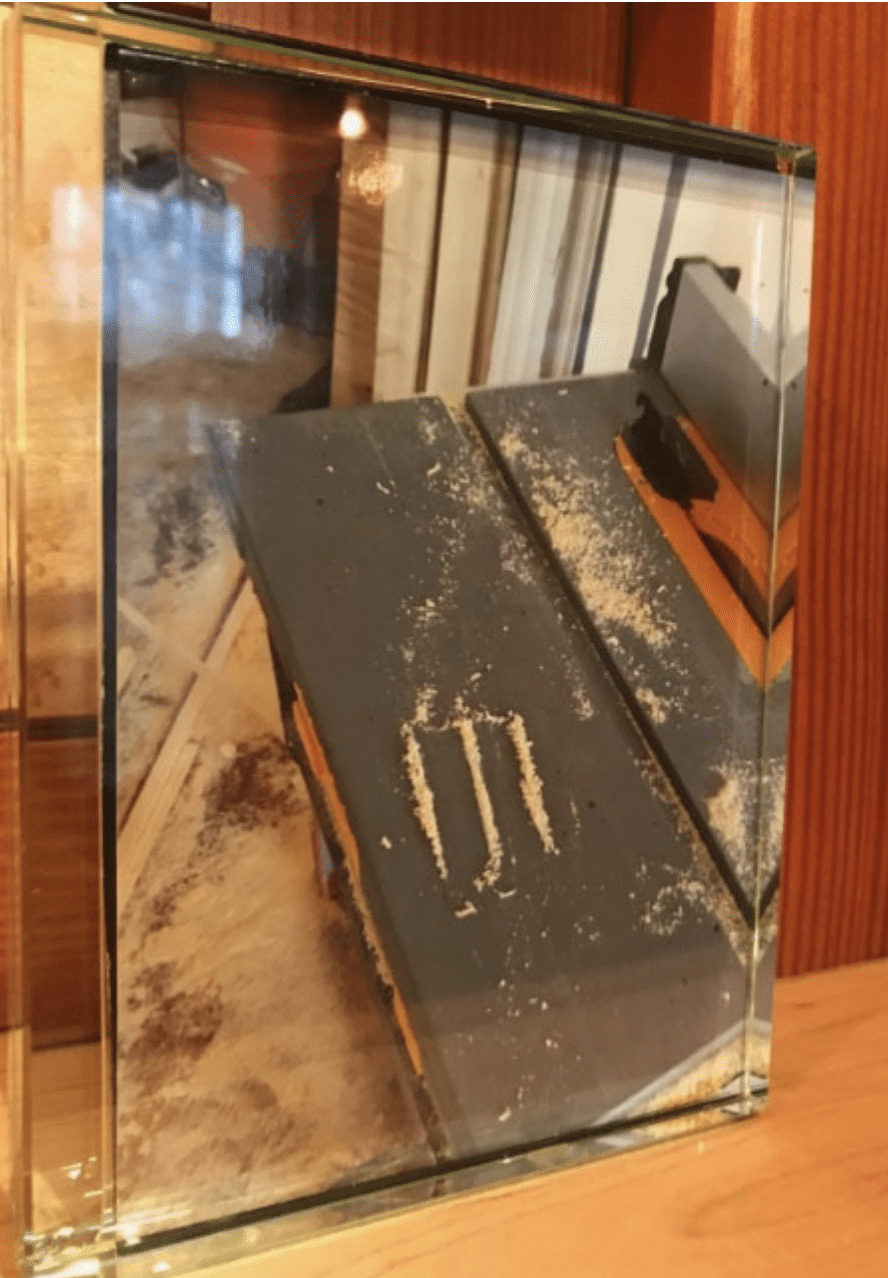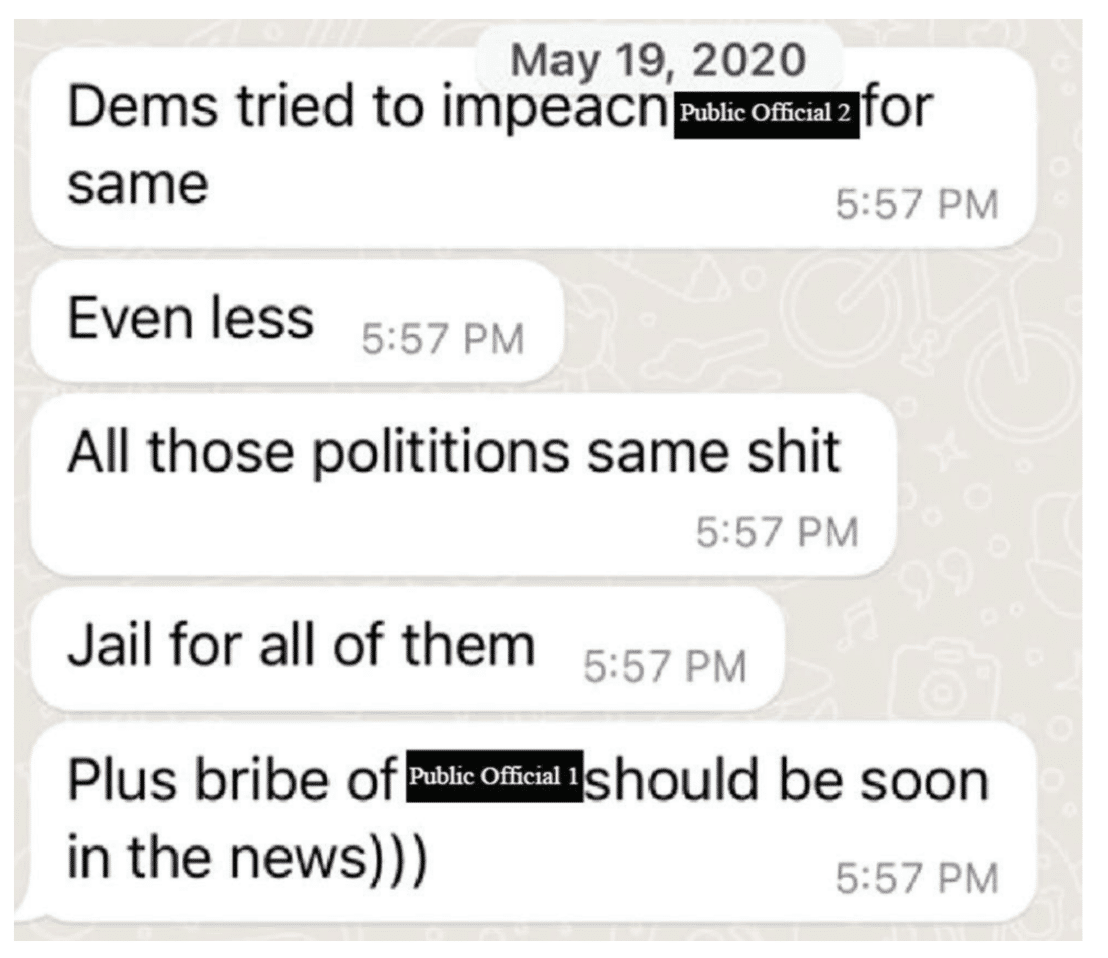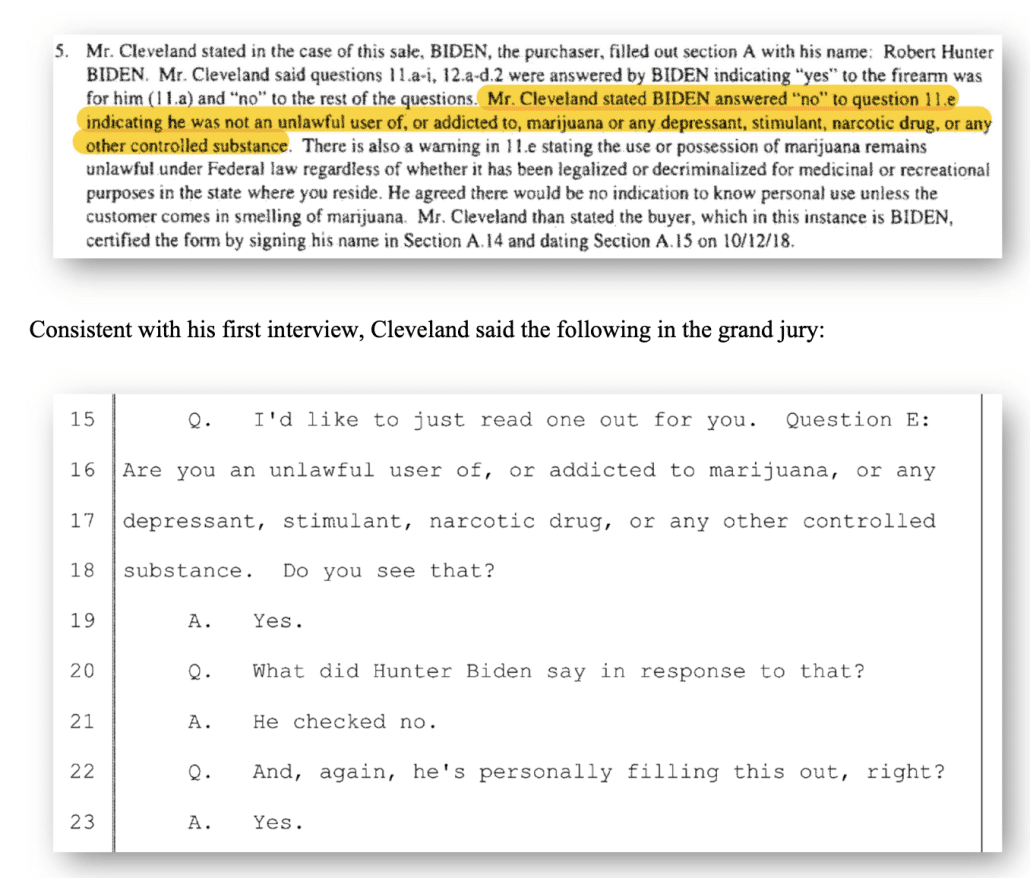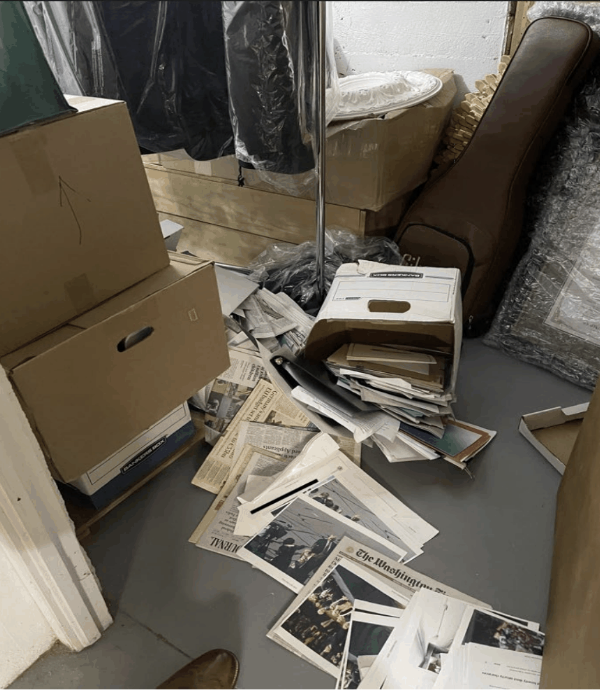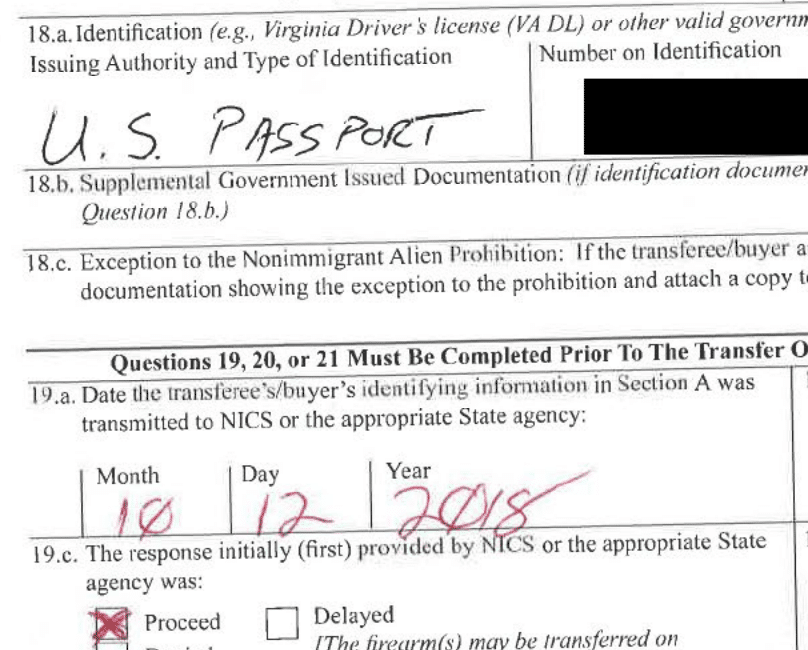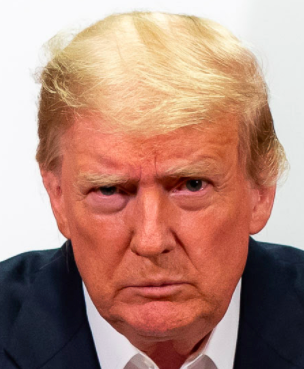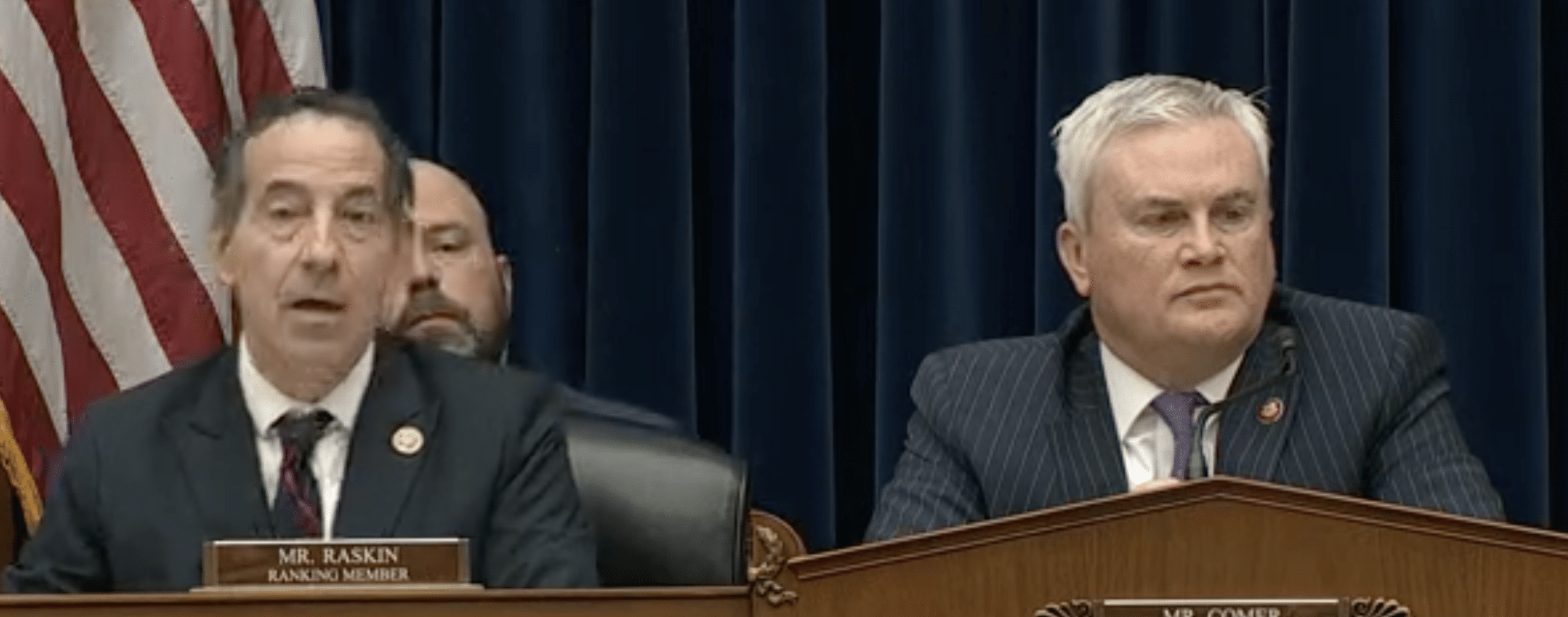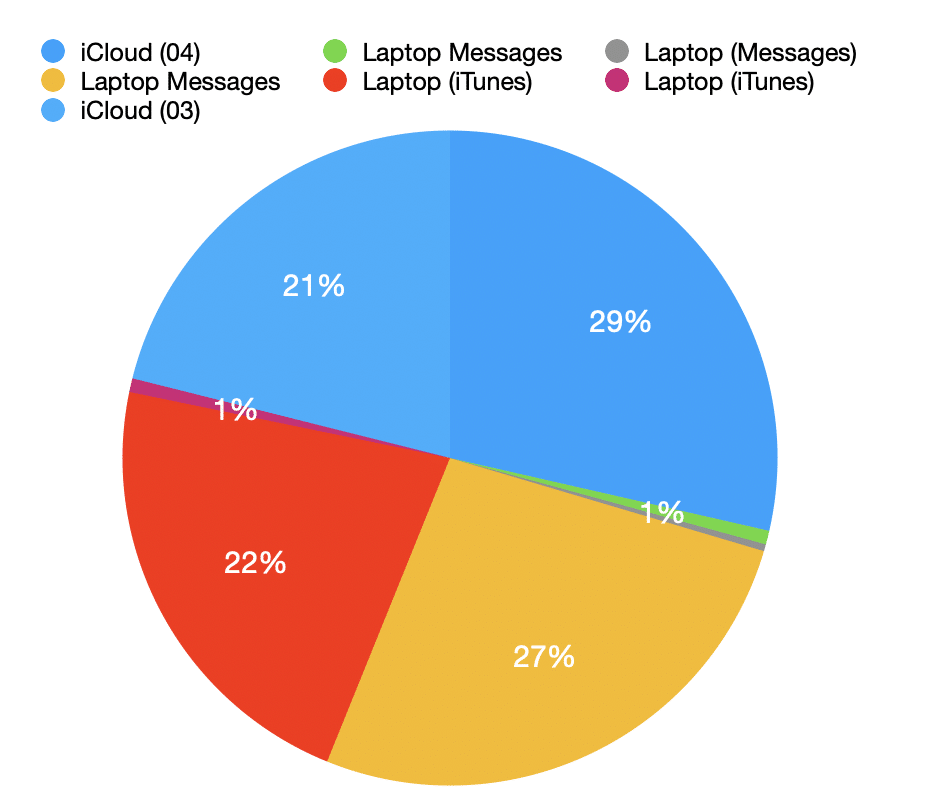In addition to their ham-handed attempt to cover up that the gun shop at which Hunter Biden purchased a gun fluffs gun purchase documents for “celebrity” purchasers, David Weiss’ team submitted their trial brief for the gun case yesterday. That, taken in conjunction with their Motions in Limine, provides a good sense of the gimmicks they plan to use to win the case against Hunter Biden. (You can find all these filings at my Hunter Biden page, which for the Delaware case is up to date.)
Ignore the Gun Shop’s Celebrity Treatment
As noted, David Weiss’ crack prosecutors only discovered that the gun shop had altered the Hunter Biden gun form after the fact when Abbe Lowell told them that at a status hearing last week.
They quickly reinterviewed gun shop employees, only to discover their testimony conflicts about whether they got that second form of ID in real time, or instead blew off doing so because Hunter was a “celebrity” purchaser and everyone knew his father.
In their belated motion in limine trying to prevent Hunter Biden from revealing that the gun shop altered this very form after the fact, prosecutors argue that relying on evidence about alterations made three years after the fact would amount to putting the gun shop owner on trial.
Except it’s not that simple. Both the 302 of the gun shop owner and the guy who sold the gun make it clear that someone in a back room is responsible for ensuring that the paperwork is in order, along with a clerk who handles the documents a third time. “He would not have paid attention to the paperwork side of the sale,” sales guy Gordon Cleveland told the FBI, “because he had already done his part by working with the customer and making the sale.” That is, the only guy in contact with the customer is not in charge of ensuring that the paperwork is in order — some guy in a back room, who submits the form to the authorities, is in charge of that.
Gun shop owner Ronald Palimere explained that his shop bifurcates the roles that way to “prevent errors.” Except even the tracking number did not get added to this form until after it was submitted to ATF; they appear to have added it after it was clear there was an investigation into the gun. The bifurcated role did the opposite of ensuring compliance.
In other words, if Judge Maryellen Noreika allows Hunter Biden to present this scandalous detail, it provides one way to sow doubt: if the gun shop was willing to alter the form three years after submission to belatedly comply with requirements, who’s to say they weren’t the ones who asserted that Hunter Biden wasn’t an addict?
Continue to Misrepresent Hunter Biden’s Memoir
When this is all said and done, I’m going to count the number of times that David Weiss and the two Trump-appointed judges justified this prosecution with a claim that everything they needed for the prosecution appeared in Hunter Biden’s memoir, with prosecutors and Judge Noreika all making false claims about what’s actually in the memoir, in the prosecutors’ case, repeatedly.
The problem is that Hunter actually didn’t say much about what happened between the time he returned to Delaware in October 2018 and when he went to Massachusetts for Ketamine treatment at the hands of Fox News pundit Keith Ablow that November. All those claims that the memoir provided abundant evidence to prove the gun case against Hunter? Nope.
And, as I’ve laid out repeatedly, what prosecutors once claimed showed the state of Hunter Biden’s addiction in October 2018, when he bought the gun, and still claim presents his continued state of addiction from October 2018, is actually his description of his addiction after (Hunter describes) the Ketamine treatment made it worse.
The therapy’s results were disastrous. I was in no way ready to process the feelings it unloosed or prompted by reliving past physical and emotional traumas. So I backslid. I did exactly what I’d come to Massachusetts to stop doing. I’d stay clean for a week, break away from the center to meet a connection I found in Rhode Island, smoke up, then return.
[snip]
Finally, the therapist in Newburyport said there was little point in our continuing.
“Hunter,” he told me, with all the exasperated, empathetic sincerity he could muster, “this is not working.”
I headed back toward Delaware, in no shape to face anyone or anything. To ensure that I wouldn’t have to do either, I took an exit at New Haven. For the next three or four weeks, I lived in a series of low-budget, low-expectations motels up and down Interstate 95, between New Haven and Bridgeport.
I exchanged L.A.’s $400-a-night bungalows and their endless parade of blingy degenerates for the underbelly of Connecticut’s $59-a-night motel rooms and the dealers, hookers, and hard-core addicts—like me—who favored them. I no longer had one foot in polite society and one foot out. I avoided polite society altogether. I hardly went anywhere now, except to buy. It was me and a crack pipe in a Super 8, not knowing which the fuck way was up. [my emphasis]
And they keep massaging this timeline. In their latest iteration in the trial brief, prosecutors try to minimize how long Hunter was in Ablow’s treatment (which, in any case, is inaccurate in Hunter’s book).
In his book, the defendant describes that he had a short stint at a therapistrun wellness center in Newburyport, Massachusetts, where the defendant says he sought drug addiction therapy.
By “brief,” these prosecutors mean Hunter claimed he spent 8 weeks in Newburyport, but the available evidence shows his follow-up trip started in mid-January, weeks earlier than he claimed in the book.
I would make two trips up there, staying for about six weeks on the first visit, returning to Maryland, then heading back for a couple weeks of follow-up in February of the new year.
As noted here, prosecutors are trying to edit the memoir to say what they want it to say, cherry picking pages and presenting them out of context. After I noted that they had excluded the part that shows Hunter arriving back in Delaware, they’ve added it belatedly in their trial brief.
7 Page 203 was inadvertently omitted from the government’s excerpts at Doc. No. 119-1. The government includes this single page in Exhibit 1 to this filing (it is the only page added to the submission at 119-1).
Abbe Lowell unsurprisingly objected to this cherry picking.
Lastly, setting aside the admissibility of additional statements from Mr. Biden’s memoir, equally concerning is the Special Counsel’s selective redaction to statements contained in the pages in Exhibit 1, without regard to the completeness of those proffered pages. For example, on page 219 (Chapter 11 title page, “Saved”), the Special Counsel included the opening sentence, “By the time my plane touched down in Los Angeles in March 2019, I had no plan beyond the momentto-moment demands of the crack pipe.” Ex. 1 at 219. However, the very next sentence on the page is redacted: “I was committed to one thing: vanishing for good.” Such a statement—whether Mr. Biden was in such despair or depression that he wanted to disappear, or worse, relent to suicidal thoughts—again goes to Mr. Biden’s then-existing state of mind, and should Mr. Biden seek its admission at trial, it ought to be admissible subject to its relevance and probative value.
[snip]
Just as importantly, these redacted pages ignore the common-law doctrine of completeness codified in Rule 106—limited to writings or recorded statements. Fed. R. Evid. 106, Adv. n.1. The rule’s purpose is to prevent a party from misleading the jury by allowing into the record relevant portions of the excluded testimony which clarify or explain the part already received. United States v. Ricks, 882 F.2d 885, 893 (4th Cir. 1989). But that is exactly what the Special Counsel has asked to do here—determining what it deems relevant, without regard to the complete context and conditions as Mr. Biden described it in his memoir.
This is one of just a few key decisions before Judge Noreika that may determine the outcome of the trial: whether she lets prosecutors effectively rewrite Hunter’s memoir so it tells a story that it really doesn’t.
Virgin Birth the Laptop
The other is what to do about the laptop.
Last August, prosecutors brashly told Abbe Lowell they didn’t need any laptop evidence to prove their case, that all of it also existed in Hunter’s iCloud data. That was, of course, over three months before they obtained the first warrant to search Hunter’s digital evidence for gun crimes, so they should not — and may not — have known how wrong they were.
Prosecutors now submitted what they bill as a summary chart of the communications they say support their case. Even more of the comms they’re relying on come from the laptop than when Derek Hines admitted they were relying on laptop comms in February.
Fully half — 148 out of 294 messages or videos — are sourced to the laptop (I’ve split out some of the laptop messages to highlight ones that are temporal outliers, which I may return to). And, as was true of Hines’ earlier filing, Weiss is relying on communications that only exist on the laptop to show Hunter’s state of mind in the period he owned the gun.
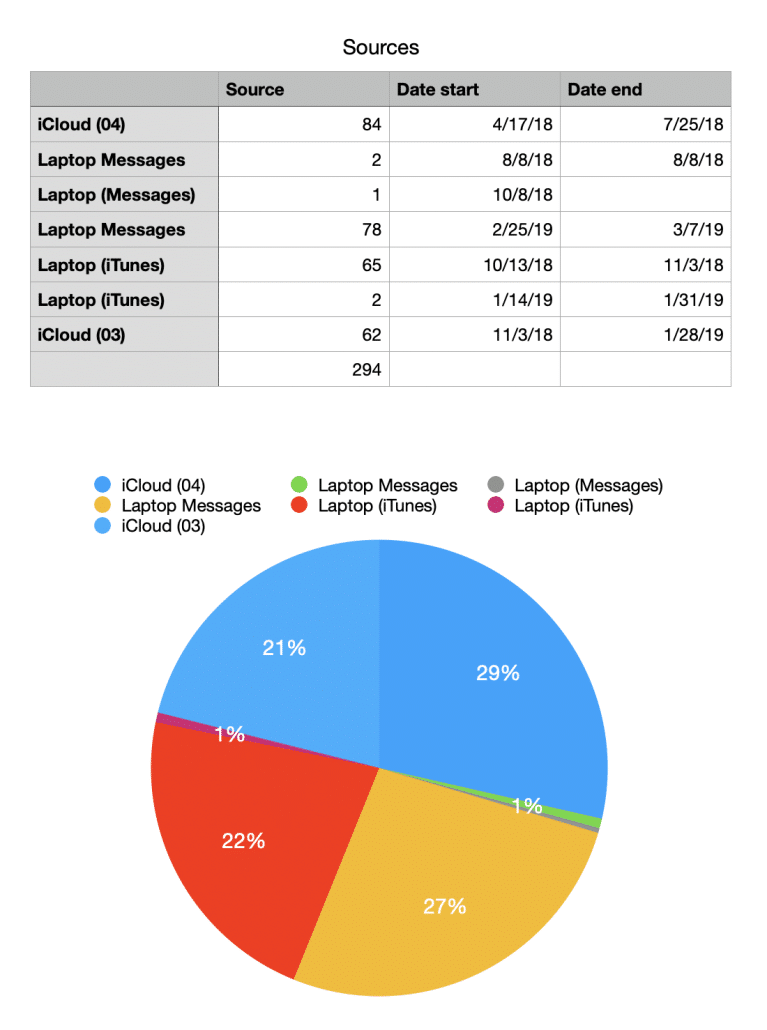
In a motion in limine, Weiss’ team tried to argue that because two FBI guys have certified that what they’ve shared is what they got from Apple and John Paul Mac Isaac, they don’t need to further validate these communications. They’re claiming this summary table is sufficient.
The government moves for a preliminary determination, as authorized by Federal Rule of Evidence 104, that a 1006 summary chart that summarizes the electronic evidence is admissible in evidence during trial, and the underlying evidence it summarizes is authentic pursuant to Federal Rule of Evidence 902(14). The summary chart satisfies the requirements of Rule 1006. The chart accurately summarizes electronic evidence derived from search warrants of the defendant’s Apple iCloud account and the defendant’s laptop and hard drive.
This ploy attempts to substitute the act of summarizing for the act of proving technical admissibility.
Unsurprisingly, the trial brief does not describe any plan to call the two technical experts — Robert Gearhart and Michael Waski — to describe the technical validity of the laptop. Weiss similarly is not calling Boyd Pritchard, the FBI agent who made a show of searching the laptop for gun crime evidence after Weiss finally got a warrant to do so.
In fact, Erika Jensen — the same woman who did interviews of the gun shop employees, at least one by herself — may be the only FBI employee (the forensic expert who tested the powder in the pouch that once held the gun may be the other) Weiss definitely plans to call to testify. And Jensen’s summary chart claims to rely on the original December 2019 laptop warrant rather than the December 2023 one as authority to have seized gun-related content.
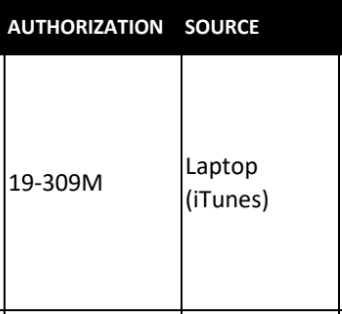
This testimony will likely make or break any ongoing career at the FBI, because prosecutors are hanging this entire prosecution on her testimony (though I guess if Trump wins the election, she can expect a fat promotion). Particularly given that she’s the sole Agent to be involved in those key gun shop interviews, this could be more difficult than originally imagined.
It is common for prosecutors to try to “clean team” damning parts of the investigation — ensuring that investigative personnel privy to inconvenient facts never take the stand. Weiss has largely clean-teamed the entire underlying investigation.
This is, unsurprisingly, the topic about which Abbe Lowell had the most to say.
The Special Counsel seeks to exclude any authenticity challenge to six iCloud backup files included in its summary chart are self-authenticating pursuant to Rule 902(14). 1 That data, obtained in 2019 and 2020 from a search warrant to Apple, Inc. and, by subpoena and later a search warrant for The Mac Shop in Delaware, consists of more than 18,000 pages from various sources, including four iCloud backup files from Apple, Inc. and two backup files from a MacBook laptop and external hard drive subpoenaed from The Mac Shop in December 2019. (D.E.120 (“Mot.”) at 1, 3.) Defense counsel has numerous reasons to believe the data had been altered and compromised before investigators obtained the electronic material from Apple Inc. and The Mac Shop, such that the Special Counsel’s claim that the underlying data is “authentic” (id. at 4) and accurately reflects “defendant’s Apple Macbook Pro and [] hard drive” (id. at 2) is mistaken.
[snip]
Mr. Biden’s counsel told the Special Counsel on May 10, 2024 it agrees not to challenge the authenticity of the electronic data the Special Counsel intends to use with respect to it being what law enforcement received on December 9, 2019 from John Paul Mac Isaac (owner of The Mac Shop), and from Apple on August 29, 2019 and in a follow-up search on July 10, 2020. (Mot. at n.3.) However, Mr. Biden cannot agree this electronic data is “authentic” as to being his data as he used and stored it prior to Mac Issac [sic] obtaining it. Mac Issac [sic] claims he received an Apple MacBook laptop from a customer on April 12, 2019. FBI investigators did not obtain that data until December 9, 2019 through a grand jury subpoena, or gain lawful permission to access it until December 13, 2019 through a search warrant (No. 19-309M), some eight months after the Mac Isaac acquired the laptop. 2
2 The prosecution only received Office of Enforcement Operations approval to seek a search warrant for the laptop and hard drive on December 12, 2019, with the warrant issued the following day. See Gary Shapley, Laptop and Hard Drive Timeline (Oct. 22, 2020), Ex. 6 to Test. before H. Comm. on Ways & Means (May 26, 2023). Any access by FBI CART agents prior to December 12, 2019 was unauthorized, and Mr. Biden’s counsel objects to the any unlawful access of the laptop or hard drive prior to December 13, 2019.
Lowell only cites John Paul Mac Isaac’s claims about accessing the laptop (which Lowell presumably has gotten in sworn fashion as part of the lawsuit), media reviews of the laptop (which probably reflect the data post-dating the FBI’s receipt of the laptop), and Lev Parnas’ description of being offered the laptop as part of Rudy’s information operation.
I’ve shown repeatedly (for example, one, two, three, four, five) that there are more indices of compromise throughout this data — indices that Weiss tries to brush away with a frankly stupid explanation that Hallie Biden will testify Hunter often “lost” phones.
Witness 3 observed that the defendant frequently lost phones and changed phones, which explains gaps in time where there are no messages.
Given the way Hunter backed up his data except on the laptop that ended up being delivered to John Paul Mac Isaac, this should not create the gaps Weiss has identified. He may have even more problems explaining why there are isolated comms in particular places where — given the temporal patterns here — they shouldn’t be.
In any case, in the five pages Lowell had, I’m not sure he has made this case. Plus, Judge Noreika is vulnerable on this point herself, having ruled that there’s no proof Rudy Giuliani influenced this case even while claiming data that is publicly available because of Rudy instead derived to Hunter’s memoir.
David Weiss’ case should be far more solid than it is. The gun shop’s alterations of gun form data provides Hunter a way to question whether he asserted he was not an addict or whether gun shop employees did. Only through shameless cherry picking have prosecutors made the memoir say what they need it to say. And Lowell should be able to raise real questions about the provenance of all the data derived from the laptop which, as I noted, includes the most important communications.
The success of what Weiss obviously thought was going to be a slam dunk may depend on Weiss’ success at getting Noreika to buy off on his gimmicks to shore up weak parts of the case.
Update: Derek Hines — he of the sawdust as cocaine — has filed a table-thumping reply accusing Hunter’s team of not understanding the laptop. He describes that Hallie will validate the comms between her and Hunter during the days after he purchased the gun.
Messages between the defendant and Witness 3, beginning in row 88 because the defendant began using his ex-wife’s phone in October 2018 and her old phone was not synced to his iCloud account. Witness 3 will testify to the authenticity of these messages at trial.
These are, without exception, the most important pieces of evidence in the case.
But then he admits he doesn’t have validation for around 83 other messages (about 21% of the total), including a bunch of videos that have mixed metadata (for example, one taken on an iPhone 8 on October 22 but saved onto the iPhone XS, another captured on October 16 but first saved on November 27, during the period when Ablow was involved).
Messages in Row 85-86 (a message where the defendant says “I need more chore boy,” which is used consistently in the message with how the defendant described “chore boy” in his book), Rows 87 and 135-137 (messages where the defendant says he in Delaware, which is consistent with his ATM withdrawal activity, location information on photographs on his phone, and his admissions in his book), Row 214 (a photograph of the defendant with a crack pipe in his hand), and 216-292 (videos and photographs of the defendant with a crack pipe and drug messages from December to March 2019, consistent with the defendant’s characterization of his activity in his book).
Hines — he of the sawdust as cocaine — is demanding that Hunter prove absence of chain of custody rather than prosecutors proving it affirmatively.
The crazier complaint comes in the way Hines — he of the sawdust as cocaine — claims that because Hunter cited Lev Parnas’ description of Vitaly Pruss’ offer of the laptop in this time period, Hunter is “asking people to believe Russian intelligence when it suits his interests.”
The defendant also relies on an allegation that a Russian businessman told a third-party that Biden’s devices were compromised by FSB during his 2014 trip to Kazakhstan. This is yet another example of the defendant asking people to believe Russian intelligence when it suits his interests, but not to believe Russian intelligence when it doesn’t suit his interests.
I get that Rudy Giuliani’s role in all this is particularly sensitive — particularly given his role in the Brady back channel that David Weiss chased credulously. But I’m not aware of any time when Hunter has chased Russian intelligence. David Weiss did that, not Hunter.
I asked Weiss’ spox for clarification, but he nodded only to court filings.

